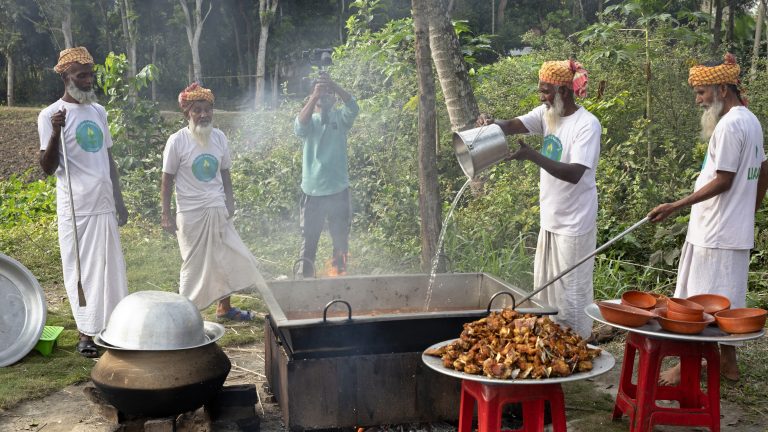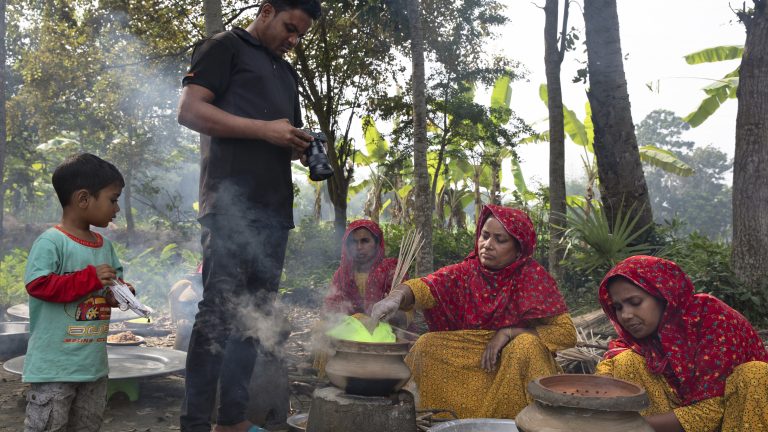Almost every week, Delwar Hussain, a stocky 40-year-old schoolteacher with betel-stained teeth, travels more than 100 miles on a public bus from his village of Shimulia in western Bangladesh to the capital city, Dhaka, carrying a 64GB SanDisk memory card carefully packed in a bag of fruits and vegetables. On a good day, this journey takes six hours, but during winter, when dense fog covers the River Padma and ferry services slow to a crawl, it can take more than 12. Once Hussain reaches the city, he heads to a cyber café owned by his nephew and business partner, Liton Ali Khan.
There, he transfers the contents of the memory card — professionally shot videos of elderly villagers preparing, cooking, and serving food to hundreds of people — to a desktop computer, from where the material is edited and uploaded to YouTube and watched by 4 million subscribers. The videos, depicting a community kitchen in Shimulia producing gargantuan quantities of food, are extravagant: meals include 14 full goat intestines, 50 country ducks, a 185-pound vanilla cake, or a 650-pound water buffalo.
The channel behind this operation is called AroundMeBD, and its success has created a whole new economy in Shimulia, which has since been dubbed the YouTube village of Bangladesh.
The YouTube village is a prominent example of a niche but is also part of a growing online trend across South Asia: As the internet reaches villages, rural societies are finding ways to showcase and monetize their unique food cultures to audiences across the world, using platforms like YouTube and Facebook. In India, Village Cooking Channel, which posts videos of large-scale traditional cooking, has over 15 million subscribers. In Pakistan, Village Food Secrets has 3.5 million subscribers. Villagers who previously had little presence in media are now using these platforms to take ownership of the way their culture is portrayed — and building businesses that support dozens, and occasionally hundreds, of individuals.
Launched by Khan in 2016, AroundMeBD emerged shortly before YouTube surged in popularity in Bangladesh. Khan was fascinated by videos from around the world, so he began to capture and upload his own surroundings on the streets of Dhaka: the noisy streets of Mirpur, handmade flower pots, and the city’s wet market, where fishermen wearing colorful traditional banians, or jockey vests, can be seen filleting fish. The videos began garnering views, and, in four months, the channel crossed 20,000 subscribers.
Soon after that, Khan decided to use AroundMeBD to showcase cooking videos based out of his village. He said that his uncle told him that would attract participants and viewers. “At first we thought of it as a picnic, like we will cook and eat the food and make videos about it,” Hussain said. “We never anticipated that these videos would be able to generate millions of views in such a short period of time.”

Over the last four years, the channel has adopted a rustic, practical visual style; it uploads about eight videos a month and has a cumulative 1.3 billion views. The eating videos have no “umms,” “ahhs,” or slurping noises to impress upon the audience an orgasmic food experience, typical of travel-cooking shows. Khan says that authenticity is the cornerstone of the channel’s success. In a video uploaded in March 2021, ten Bengali women dressed in pink squat on an open field hacking away at a 234-pound monster tuna. The preparation takes hours: they fillet the tuna, chop it up into hundreds of tiny pieces and hold them up for the camera filming them. The stew is cooked over a wood fire on a large flat metal pan, the sizzle accompanied by Bengali chatter and the sounds of wind and bird calls. Then, the meal is dished out to over 400 guests seated cross-legged in an open field.
The huge size of the dishes is not about the unrestrained indulgence one sees in South Korea’s mukbang eating challenges, but an act of philanthropy. “All villagers — irrespective of their financial condition, creeds, religions — can come here and eat the food [that’s cooked for the videos],” Hussain said.
As the channel’s popularity has grown, Khan and Hussain have hired people in the village to plan the shoots and manage the crowds that come to eat, as well as delegated responsibility, to make the channel a self-sustaining endeavor. The channel now employs around 50 workers, including 17 women, who feature in the videos and run the show.
The shoots are led by Shojib Hossain, one of AroundMeBD’s first employees, who started working at the channel right out of high school, and two cameramen.

Khan says that Hossain and his team had no video experience prior to working on the channel but that they have learned the tricks of the trade — wide angle, zoom shot, shutter speed adjustment, and more — by watching camera tutorials on YouTube. Their arsenal today includes a DJI drone, and five professional cameras, including a Canon EOS 750, a Sony Alpha NEX-6 and Alpha 7.
Despite the technical progress, internet connectivity in the village is still limited — necessitating Hussain’s treks to Dhaka.
The channel often shows the same cooks over and over, and the stars are unpretentious but amused by their sudden fame.
Jobeda Khatun, a 70-year-old single mother, has appeared in over 100 AroundMeBD videos. She’s never lived outside Shimulia, and her only possessions are a parcel of cultivable land and a house. She says that participating in the channel earns her Tk 3,000 ($35) a month, which helps afford medicine for her diabetes and put food on the table for her family. “I can’t thank Liton enough for giving me the chance to cook for AroundMeBd. It’s such fun. I enjoy every minute of it. We get to eat various kinds of fishes and meats which otherwise we couldn’t afford,” Khatun told Rest of World.

The rise of rural cooking channels like AroundMeBD is tied to a sense of fascination, says Craig Richard, author of the book Brain Tingles, who studies how the brain reacts to relaxing triggers on YouTube videos. “Village cooking videos fall into the general category of ‘oddly satisfying’ videos,” he told Rest of World. “The two common traits of all oddly satisfying videos tend to be novelty and transformation.” The viewers witness something they don’t normally see in their everyday lives in these videos, and they also see the subject of the video undergo some type of change. Richard says factory, demolition, ASMR, and mukbang are other subgenres in this video category that have a relaxing effect on the audience.
Most viewers are in awe of the camaraderie of the villagers: “Community spirit is strong here, a light for others to follow. Love the channel,” wrote Mark Futcher, a longtime viewer of the channel. “I love the community centric life of our rural folks. Love this video through n through,” writes Singboy, a viewer from India. The comments section is filled with praise in Russian, English, Spanish, Hindi, and more. Khan said that about 32% of the channel’s viewers and earnings were from India, followed by Bangladesh and the U.S., with each contributing 4% viewership.
“My telephone number is given to several markets in Dhaka; they call me if there is any special fish. When the price is right, they send it over.”
Channels like AroundMeBD and Village Cooking Channel can be big business. AroundMeBD refused to disclose the revenue earned through the channel, but according to other YouTubers in Bangladesh whose accounts are of similar size, an account like AroundMeBD could bring in a few million dollars annually.
Producing videos for the channel comes with considerable expenses: crews spend about Tk 1,000,000 (~ $11,630) on video production every month, with the lion’s share of that spent on sourcing ingredients, which can include exotic meats like lobster, swordfish, and buffalo tongue. Khan says that on average, the channel uses Tk 300,000 (around $3,500) worth of fish every month. Up to Tk 15,000 (around $175) is spent every week on transporting the massive amounts of meat.
“My telephone number is given to several markets in Dhaka; they call me if there is any special fish,” Khan said. Fishmongers often call him on IMO or WhatsApp when they’ve found particularly large specimens. “When the price is right, they send it over,” Khan said. He settles up through Bkash, a near-ubiquitous mobile money service in Bangladesh.
The success of the channel has drawn in sponsorship opportunities. Khan says that the channel has so far received at least 20 sponsorship offers, including from Pran Foods, one of the largest food companies in Bangladesh. “But we refused all of them, as we wanted to keep our videos authentic,” he said. “I know sponsorship would have gotten us more money, but it would have compromised the simplicity and authenticity of our videos.”

Meanwhile, the channels’ success is having ripple effects throughout the village. Proceeds from the operation have gone toward building amusements like life-sized giraffe replica, a giant duck, an elephant made of straw, and a water slide for kids. There are now plans to build a city park.
Additionally, when a fire burned down several houses in the village, the ad revenue from YouTube was used to rehome those who lost theirs in the fire. The channel also foots medical expenses for the elderly in the village. “If any of the grandpas or women in the channels has a problem, we cover the majority of the medical expenses — be it to consult a doctor or for treatment,” Khan said.
But Khan knows that his YouTube success may be ephemeral and is trying to diversify his media empire.
In 2020, after AroundMeBd crossed around 3 million subscribers, Khan launched Village Grandpa’s Cooking. The channel has a similar premise — large-scale cooking — but the protagonists are four septuagenarian grandpas sporting long white beards.
They go to the houses of old, physically and mentally challenged people and distribute food among them. They also distribute blankets and household necessities to the needy. The Village Grandpa’s Cooking channel currently has close to 1 million subscribers. Khan’s other YouTube channels include Fortunate Guest, Creative Boy’s Craft, and The Great Foodie — all of which are yet to take off.
Khan’s ultimate dream is to turn the village into a top tourist destination in Bangladesh. “You know lots of people from different parts of the country as well as from abroad now come to see our activities,” Hussain said. “We have plans to build a gate to mark the entrance of our village [and have] plans to install several wooden planks — indicating the direction towards our village — on the way from Khoksha, so that people have no difficulty finding our village.”





